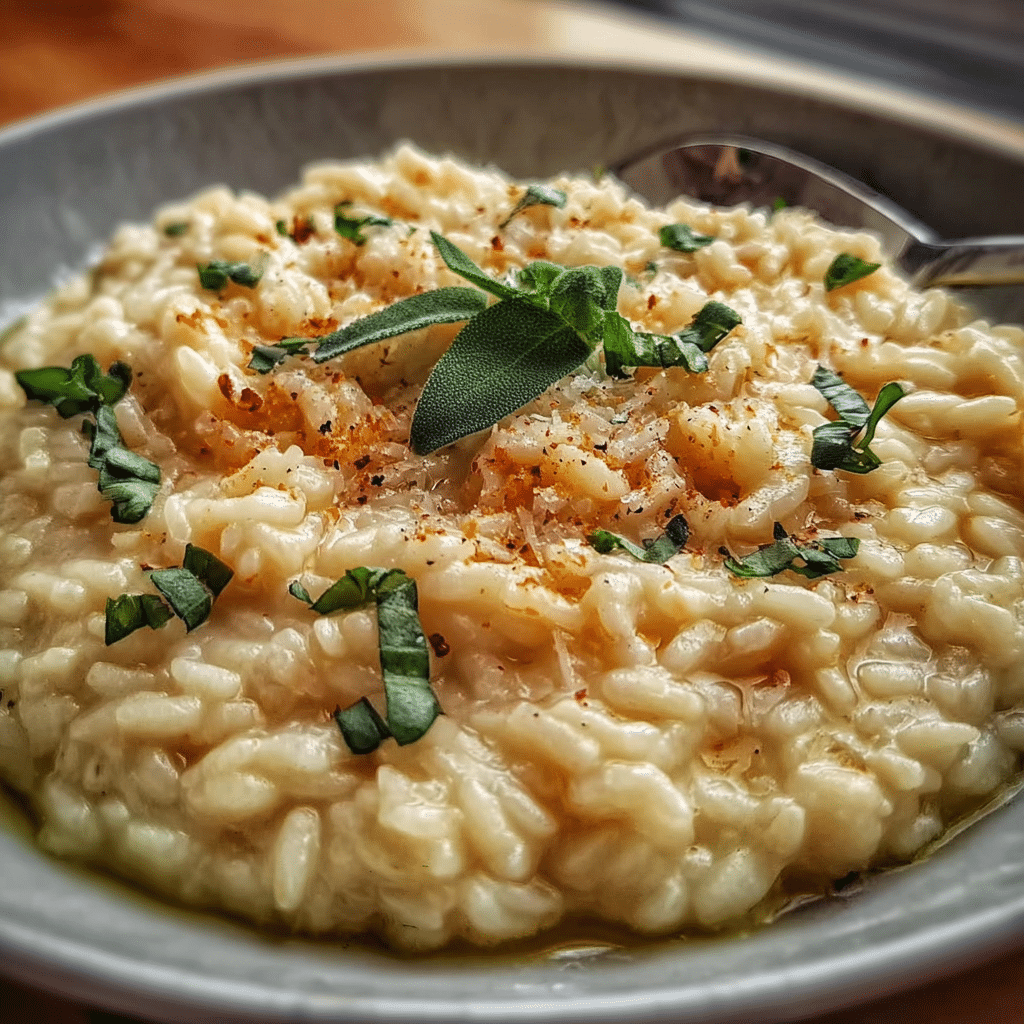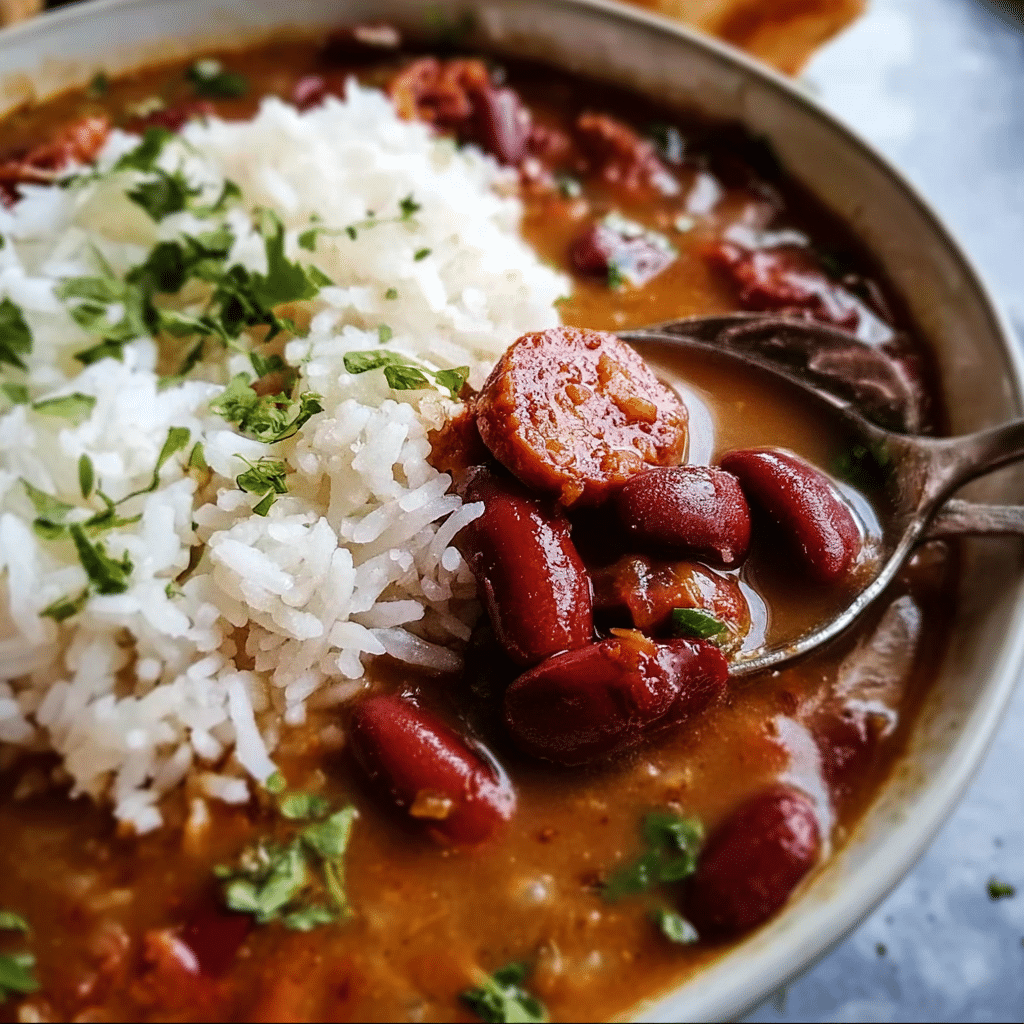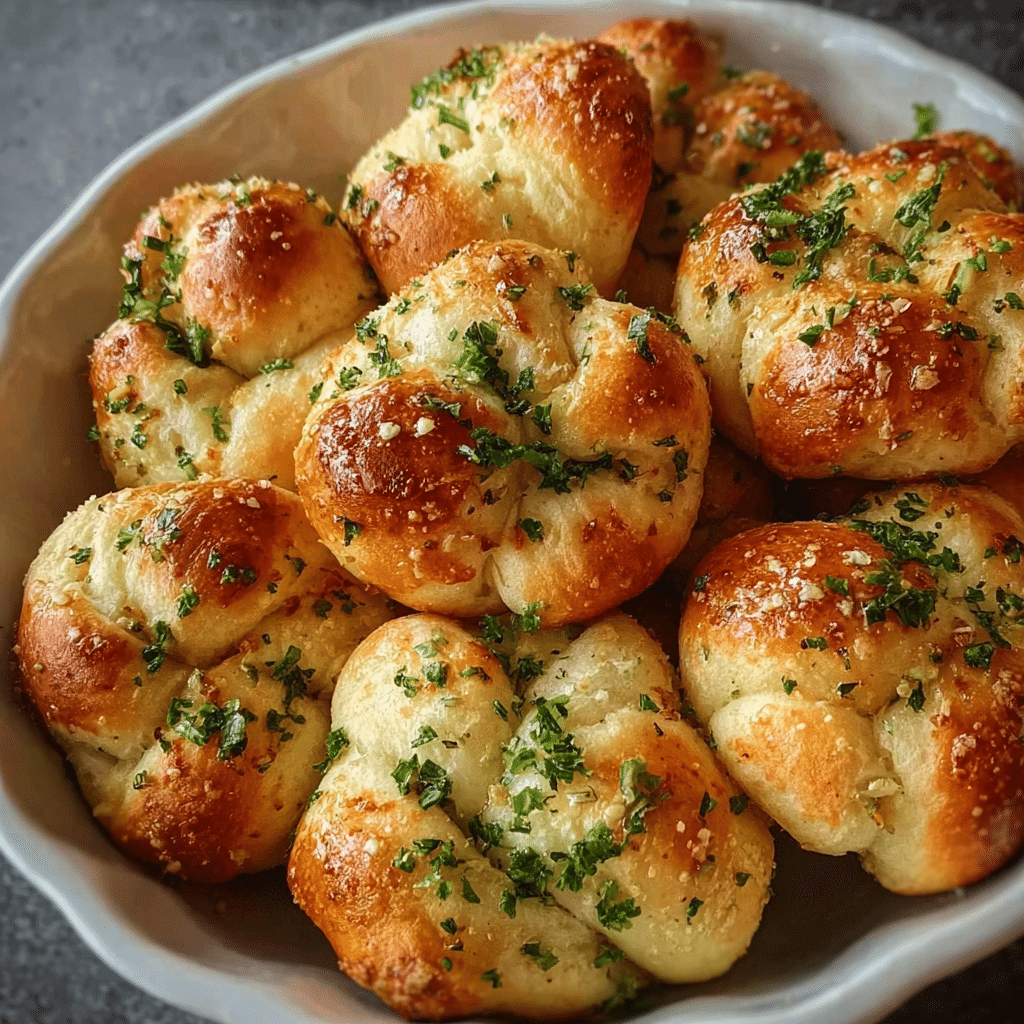Grandma’s thanksgiving stuffing is not just a dish; it’s a cherished tradition that evokes memories of laughter, family gatherings, and the comforting aroma that fills the house as the holidays approach. I remember the first time I truly appreciated this recipe. It was a brisk November afternoon, and I was just a teenager, too young to grasp the full significance of our family’s Thanksgiving traditions. My grandmother was in the kitchen, her hands moving deftly as she prepared her famous stuffing. The entire house smelled of sage, thyme, and the rich, buttery aroma of bread toasting in the oven. I was captivated, not just by the delicious smells but by the way my grandmother spoke of the dish. “This,” she said, “is our family’s heart.”
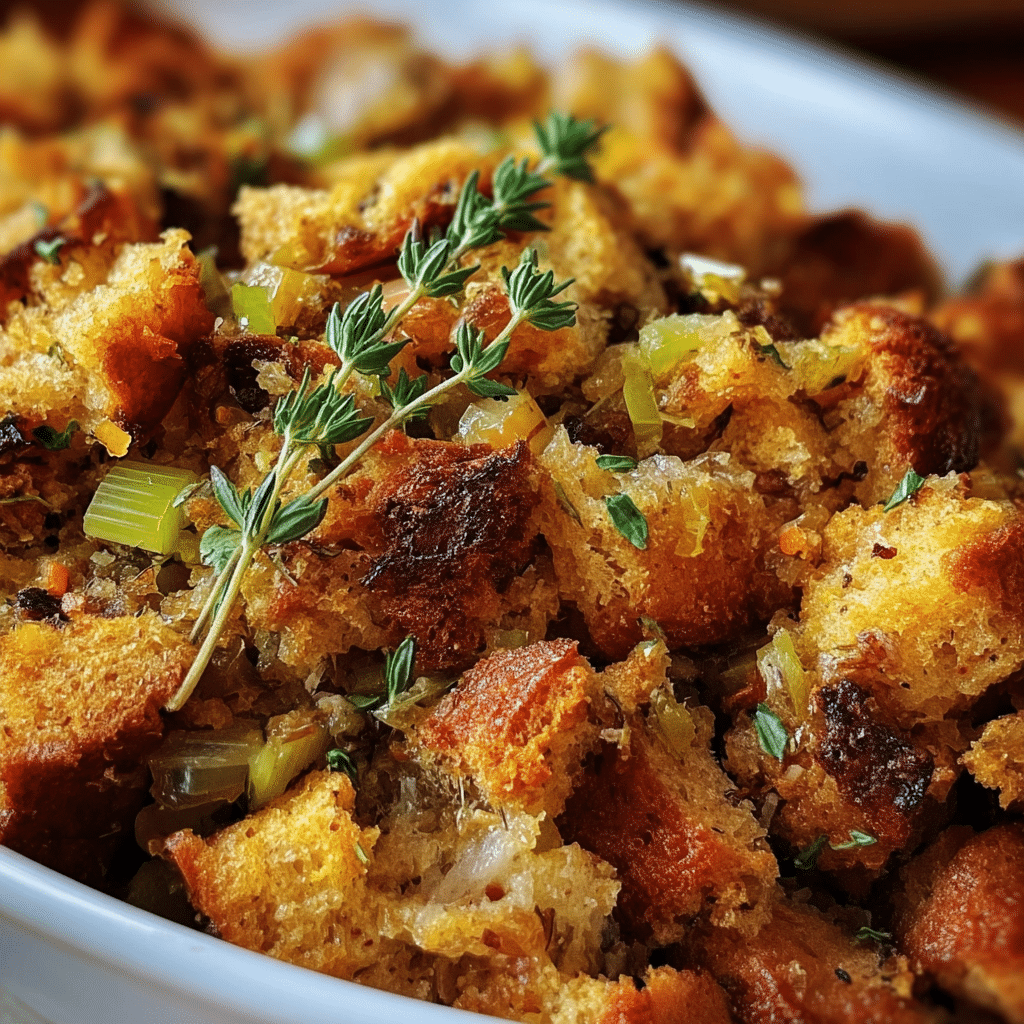
As I helped her chop vegetables and mix ingredients, she shared anecdotes about her own childhood and how her mother had taught her the recipe. It was a rite of passage, a way to pass down not just a recipe but a piece of our family history. This moment was the start of my love affair with grandma’s thanksgiving stuffing, and since then, I’ve made it a point to prepare it every year. It’s become a tradition that I now share with my own children, making it a multi-generational celebration of flavors and memories.
The Story Behind This Recipe
The origins of grandma’s thanksgiving stuffing are as rich as the dish itself. Stuffing, or dressing as some may call it, has been a part of Thanksgiving celebrations for centuries. The earliest versions can be traced back to ancient times when people would stuff meats with a variety of ingredients to enhance flavor and utilize leftover scraps. The practice evolved over the years, and by the 19th century, stuffing made its way into the American Thanksgiving tradition as a way to elevate the humble turkey to something truly special.
What sets grandma’s thanksgiving stuffing apart from other recipes is the love and care that goes into it. While many recipes may focus on new ingredients or trendy flavors, my grandmother stuck with the classic elements: stale bread, fresh herbs, and an array of sautéed vegetables. Each ingredient plays a crucial role, creating a balance of texture and flavor that is simply unmatched. It’s this simplicity that makes the dish perfect for busy families looking for quick dinner solutions. You can prepare grandma’s thanksgiving stuffing ahead of time, allowing you to enjoy more time with loved ones on the big day.
Why You’ll Love This Dish
Seasonally, grandma’s thanksgiving stuffing is best made during the fall, as the harvest brings an abundance of fresh ingredients. It’s the time of year when families gather to celebrate the bounty of the earth, and what better way to honor that than with a dish steeped in tradition? The emotional connection to this recipe is profound; it’s not just about the stuffing itself but the memories it conjures. Each bite takes me back to that kitchen, filled with the laughter of family and the warmth of home.
In this article, readers will learn not only how to recreate grandma’s thanksgiving stuffing but also how to infuse their own personal touches into the recipe, ensuring that it remains a living tradition in their own families. From selecting the right bread to balancing flavors with herbs and spices, I’ll guide you through each step to make this dish a centerpiece of your holiday table. Join me on this culinary journey, and let’s celebrate the love and joy that comes with grandma’s thanksgiving stuffing.
The Rich History and Cultural Significance of grandma’s thanksgiving stuffing
Exploring the grandma’s thanksgiving stuffing recipe is like taking a deep dive into a rich cultural tapestry woven over centuries. The roots of stuffing can be traced back to various ancient civilizations, where the concept of stuffing meats and other foods was common. The word “stuffing” itself comes from the French term “farcir,” which means to stuff or fill. This practice allowed cooks to utilize every part of the animal and make the most of available ingredients, a concept that resonates with today’s emphasis on sustainability and minimizing waste.
Origins and History
In America, stuffing became an integral part of the Thanksgiving meal during the 19th century, a time when the celebration of the harvest became a national holiday. Early American settlers blended their culinary traditions with those of Native Americans, incorporating local ingredients such as corn and nuts into their stuffing. The dish evolved with regional variations, from the cornbread stuffing of the South to the oyster stuffing popular in New England. Each version tells a story of the land, the people, and their unique cultural experiences.
As generations passed, family recipes for grandma’s thanksgiving stuffing began to take shape. My grandmother’s recipe, for example, has been handed down through the generations, each family member adding their twist. This evolution is a testament to how food can reflect changing times while still holding onto its roots. My grandmother would often say, “Every pinch of spice carries a memory,” and I firmly believe that each version of stuffing encapsulates the history and culture of its maker.
Cultural Significance
In many households, grandma’s thanksgiving stuffing is not just a side dish; it symbolizes the gathering of family and friends. During Thanksgiving, it represents gratitude and sharing, bringing people together around the table. The preparation of stuffing often becomes a communal activity, with family members contributing their favorite ingredients or cooking methods, which only enriches the experience.
Historically, stuffing has been served not only during Thanksgiving but also during significant family gatherings such as Christmas and Easter. The dish embodies comfort and nostalgia, often evoking fond memories of loved ones who are no longer with us. For many, the act of cooking and sharing this beloved recipe becomes a way to honor those who have passed, keeping their memory alive through food.
Nutritional Benefits
While grandma’s thanksgiving stuffing is often seen as an indulgent dish, it can also offer nutritional benefits, depending on the ingredients used. Traditional recipes are based on bread, vegetables, and herbs, which can provide essential nutrients and fiber. Whole grain breads can enhance the nutritional content, offering more fiber and vitamins than white bread. Adding a variety of vegetables not only enhances flavor but also boosts the vitamins and minerals in the dish.
Moreover, herbs such as sage and thyme are not only flavorful but also have health benefits; they are known for their anti-inflammatory and antioxidant properties. By making a few smart substitutions, such as using low-sodium broth or incorporating more vegetables, you can create a stuffing that is both delicious and nutritious. This adaptability makes grandma’s thanksgiving stuffing a perfect dish for contemporary families looking to balance tradition with health-conscious choices.
In conclusion, understanding the rich history and cultural significance of grandma’s thanksgiving stuffing adds depth to the experience of cooking and sharing it. It’s not just about the ingredients or the method; it’s about the stories, memories, and connections that come along with it. As you embark on making this beloved dish, remember that you are participating in a long-standing tradition, one that has been shared through generations, and one that will continue to bring families together for years to come.
Essential Ingredients for Perfect grandma’s thanksgiving stuffing
When it comes to creating the perfect stuffing for your Thanksgiving feast, there’s something truly special about grandma’s thanksgiving stuffing. This cherished recipe has been passed down through generations, filled with flavors that evoke warm memories of family gatherings and holiday cheer. To achieve that nostalgic taste, it’s essential to gather the right ingredients. Below is a comprehensive list of all the necessary components, along with tips and insights to ensure you create a stuffing that will leave everyone at the table craving more.
Essential Ingredients
- 1 loaf of day-old bread (about 1 pound, cubed)
- 1/2 cup unsalted butter
- 1 large onion, diced
- 2-3 stalks of celery, diced
- 2 cups chicken or vegetable broth
- 1 tablespoon fresh sage, chopped (or 1 teaspoon dried sage)
- 1 tablespoon fresh thyme, chopped (or 1 teaspoon dried thyme)
- 1 tablespoon fresh parsley, chopped
- 1 teaspoon salt
- 1/2 teaspoon black pepper
- 1/2 cup dried cranberries or raisins (optional)
- 1/2 cup chopped pecans or walnuts (optional)
- 2 large eggs, beaten (optional for moisture)
Each ingredient plays an integral role in achieving the delicious flavor and texture that grandma’s thanksgiving stuffing is known for. For instance, the day-old bread is crucial because it absorbs the broth without becoming mushy. A loaf that has been left out for a day develops a firmer texture, which helps hold the stuffing together when baked.
Butter adds richness and depth to the stuffing, imparting a savory flavor that complements the other ingredients. Be sure to use unsalted butter, as this allows you to control the sodium content more effectively. Onions and celery form the aromatic base of the stuffing, providing that classic savory profile that you would expect from grandma’s kitchen.
Herbs like sage, thyme, and parsley are what bring grandma’s thanksgiving stuffing to life. These herbs are not only aromatic but also add a layer of freshness that balances the richness of the butter and broth. Fresh herbs are preferred when available, but dried herbs can be used if you’re in a pinch. Just remember that dried herbs are more potent than fresh, so adjust your measurements accordingly.
Print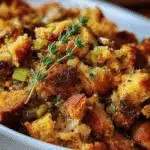
Grandma’s Thanksgiving Stuffing Recipe
Ingredients
- 13–15 cups dry bread cubes* about 2 1 pound loaves (We like to use a heavier bread such as French bread so it soaks up more juice)
- 1 1/2 cups unsalted butter
- 1 cup chopped celery
- 1 cup diced yellow onion
- 2 1/4 teaspoons salt
- 1 teaspoon ground black pepper
- 1 1/2 tablespoons poultry seasoning
- 1 1/2 cups chicken stock (I use low sodium chicken broth)
- 2 large eggs
Instructions
- Preheat the oven to 350ºF. Spray a 2 quart casserole or 9×13″ baking dish with cooking spray.
- In a large skillet, sauté the onion and celery in the butter over medium-high heat for 10-12 minutes, or until the onion and celery are tender. 1 ½ cups unsalted butter, 1 cup chopped celery, 1 cup diced yellow onion
- Place the bread cubes in a large bowl. 13-15 cups dry bread cubes*
- Pour the butter, onion and celery mixture over the bread cubes and mix. Add the remaining ingredients and mix well. 2 ¼ teaspoons salt, 1 teaspoon ground black pepper, 1 ½ tablespoons poultry seasoning, 1 ½ cups chicken stock, 2 large eggs
- Spread the stuffing evenly in the prepared baking dish. Bake for 30-35 minutes or until golden brown.
- Garnish with fresh parsley or other fresh herbs such as rosemary if desired.
Shopping Tips
When shopping for ingredients for grandma’s thanksgiving stuffing, look for the freshest options available. For bread, a rustic loaf such as a sourdough or whole grain can enhance the flavor. If you have a local bakery, consider purchasing fresh bread from there, or you can opt for organic varieties that often have no preservatives.
For vegetables, selecting crisp, fresh celery and onions can make a noticeable difference in taste. When it comes to herbs, check for vibrant green leaves and a fresh scent; these are indicators of quality. If you have a farmer’s market nearby, that’s a great place to find seasonal produce, especially around Thanksgiving when many local farms are harvesting their crops.
As for the broth, homemade is always best if you have the time; however, high-quality store-bought varieties can also be used. Look for low-sodium options if you’re watching your salt intake. And if you’re cooking for vegetarians or vegans, vegetable broth is an excellent alternative that won’t compromise the flavor.
Substitutions and Alternatives
Dietary restrictions shouldn’t prevent anyone from enjoying grandma’s thanksgiving stuffing. Here are some substitution options:
- Gluten-Free: Use gluten-free bread or cornbread as a base. There are many excellent gluten-free options available on the market today.
- Dairy-Free: Substitute the butter with olive oil or coconut oil to keep the stuffing rich without using dairy.
- Egg-Free: If you want to skip the eggs, consider adding a bit more broth or using a flaxseed meal mixed with water as a binding agent.
- Nut-Free: If you have nut allergies, simply omit the nuts or replace them with sunflower seeds for some crunch.
Additionally, if you find yourself with leftover ingredients after preparing your stuffing, consider storing them properly. Bread can be frozen for later use, while fresh herbs can be chopped and frozen in ice cube trays with a bit of oil for easy access to flavor boosts in future dishes. Diced vegetables can also be stored in airtight containers in the refrigerator for up to a week.
As the Thanksgiving season approaches, be mindful of your budget. Consider buying in bulk for items like bread or herbs, and take advantage of sales on seasonal produce. Organic options can be pricier, but if you’re concerned about pesticides or want to support local farmers, it’s worth it to invest a bit more in quality ingredients that will make grandma’s thanksgiving stuffing shine.
In conclusion, getting the right ingredients is the first step to making a delicious grandma’s thanksgiving stuffing that will warm hearts and bellies. With careful selection and thoughtful substitutions, you can create a stuffing that honors the traditions of the past while accommodating today’s dietary preferences. Now that we have our ingredients sorted, let’s move on to the cooking process!
Detailed Step-by-Step grandma’s thanksgiving stuffing Cooking Instructions
Now that we have gathered all the essential ingredients for grandma’s thanksgiving stuffing, it’s time to walk through the detailed cooking instructions. Each step in this process is not just about following a recipe; it’s about creating an experience filled with aromas, flavors, and memories. So, let’s dive into how to transform those ingredients into a delightful stuffing that will be the star of your Thanksgiving table.
Preparation Steps
- Prepare the Bread: Start by cutting your day-old bread into cubes. Aim for about 1-inch pieces. If your bread is really dry, feel free to let it sit out for a day or two beforehand. For those who prefer a more rustic stuffing, you can tear the bread instead of cutting it. Spread the cubes out on a baking sheet and toast them in a 350°F (175°C) oven for about 10-15 minutes until they’re golden brown. This step is crucial, as it helps the bread to soak up the broth without becoming overly soggy.
- Mise en Place: While the bread is toasting, take this time to prepare your vegetables. Dice your onion and celery finely. Having everything prepped and ready to go will make the cooking process smoother and more enjoyable.
- Cook the Aromatics: In a large skillet, melt the unsalted butter over medium heat. Once it’s melted and bubbling, add the diced onion and celery. Cook these until they’re softened and translucent, about 5-7 minutes. This step not only builds flavor but also releases the natural sweetness of the vegetables, which will make your stuffing taste even better.
- Add the Herbs: Once the vegetables are softened, it’s time to add the fresh herbs. Stir in the sage, thyme, and parsley, allowing them to cook with the aromatics for an additional minute or so. The heat will release the oils from the herbs, infusing the butter and vegetables with incredible flavor.
- Combine Everything: In a large mixing bowl, combine the toasted bread cubes and the sautéed vegetable mixture. Gently toss them together, ensuring the bread is evenly coated with the buttery goodness. This is also the moment to add any dried cranberries or nuts if you’re using them.
- Add the Broth: Pour in the chicken or vegetable broth gradually, mixing as you go. You want the stuffing to be moist but not soggy. If you’re using eggs for added moisture, now is the time to incorporate the beaten eggs into the mixture, which will bind everything together during baking.
Cooking Process
- Preheat the Oven: Preheat your oven to 350°F (175°C) while you finish mixing the stuffing. This will ensure that when you place your stuffing in the oven, it cooks evenly and thoroughly.
- Transfer to Baking Dish: Spoon the stuffing mixture into a greased baking dish. Press it down gently but don’t compact it too much; you want to maintain some airiness for texture. For a crispy top, you can sprinkle a bit more butter or olive oil over the top before baking.
- Bake the Stuffing: Place the baking dish in the preheated oven and bake for about 30 minutes, or until the top is golden brown and crispy. If you want an extra crunchy top, you can switch the oven to broil for the last few minutes, but watch it closely to prevent burning.
- Visual and Sensory Cues: While the stuffing is baking, keep an eye on it. You’ll know it’s done when the edges are crispy and the center is steaming hot. The aroma that fills your kitchen will be a hint that something special is happening!
Final Assembly
- Let it Rest: Once baked, remove the stuffing from the oven and let it rest for about 10 minutes before serving. This allows the flavors to meld together even more, making each bite a delightful experience.
- Serving Suggestions: Grandma’s thanksgiving stuffing can be served right from the baking dish or transferred to a serving bowl. It pairs beautifully with turkey, gravy, and cranberry sauce. Don’t forget to encourage your guests to go back for seconds—there’s nothing quite like the joy of sharing a beloved family recipe!
- Storing Leftovers: If you happen to have any leftovers (which is rare with a dish this delicious), store them in an airtight container in the refrigerator. They can last for up to three days. Reheat in the oven or microwave, adding a splash of broth to keep it moist.
Remember that cooking is as much about the journey as it is about the destination. With each step, you’re not just making grandma’s thanksgiving stuffing; you’re creating memories that will last a lifetime. Embrace the process, enjoy the aromas wafting through your kitchen, and most importantly, savor the time spent with loved ones around the table. Happy cooking!
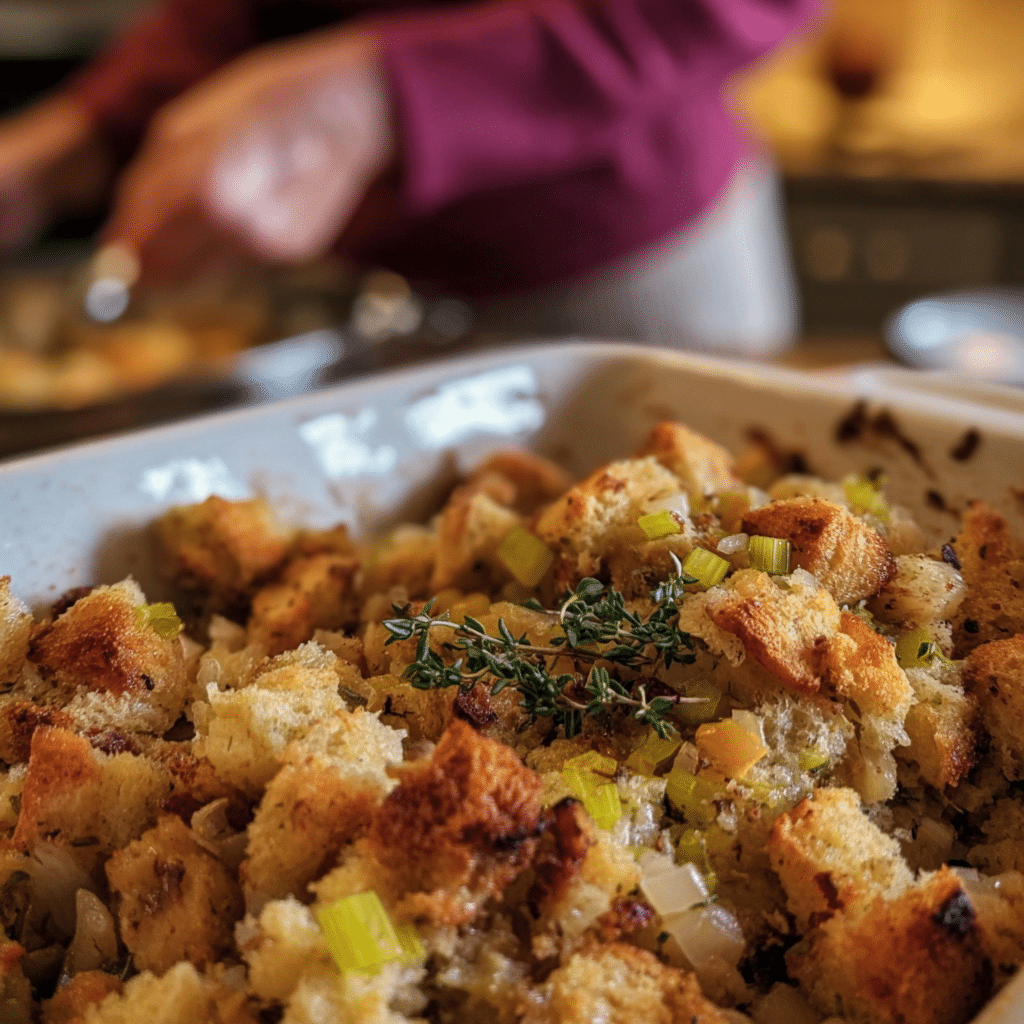
Professional Tips and Techniques for grandma’s thanksgiving stuffing
When it comes to Grandma’s Thanksgiving stuffing, there’s a certain magic in the air, a blend of nostalgia and culinary tradition that warms the heart and fills the belly. But achieving that perfect stuffing is an art, one that requires not just a good recipe, but also some insider techniques and tips that can elevate your dish from good to unforgettable. Here, I’ll share my professional tips and techniques for crafting the ultimate grandma’s Thanksgiving stuffing.
Professional Techniques
First and foremost, let’s talk about the bread. The foundation of any great stuffing is, of course, the bread used. While some may opt for pre-packaged stuffing crumbs, I highly recommend going the homemade route. Use a good quality bread—preferably a day or two old—like sourdough, French bread, or even cornbread. Stale bread holds its shape better and absorbs the flavorful liquids without becoming mushy. You can cut it into cubes or tear it into pieces for a rustic feel.
Next, consider the aromatics. Sautéing onions, celery, and garlic in butter is a classic approach, but don’t shy away from adding herbs like sage, thyme, and rosemary for that quintessential Thanksgiving flavor. I remember my grandmother using fresh herbs from her garden, which added an earthy depth to the stuffing. The key is to sauté these ingredients until soft and fragrant, allowing the flavors to meld beautifully before combining them with the bread.
Now, let’s discuss moisture. Achieving the perfect texture in grandma’s Thanksgiving stuffing is all about striking a balance between dry and wet ingredients. A common mistake is to drown the stuffing in broth—start with a small amount and gradually add more until you reach your desired consistency. The stuffing should be moist but not soggy. For a twist, consider adding some apple cider or white wine to the broth for a hint of sweetness and acidity that brightens the dish.
Troubleshooting Guide
Even the best cooks face challenges in the kitchen. If your stuffing is too dry, try adding a bit more broth or a splash of melted butter. If it’s too wet, you can bake it uncovered for a short time to allow some moisture to evaporate. The texture can also be affected by the type of bread you use, so if you’re experimenting, keep this in mind.
For those who prefer a crispier topping, consider spreading the stuffing in a larger baking dish or even a cast-iron skillet for more surface area. This way, the edges brown beautifully, creating that delightful contrast of textures. If you find that the top isn’t browning as you’d like, a few minutes under the broiler can work wonders—just keep an eye on it to prevent burning!
Presentation Tips
When it comes time to serve grandma’s Thanksgiving stuffing, presentation matters. I love to serve my stuffing in the skillet or baking dish it was cooked in; it adds a rustic charm to the table. Garnish with fresh herbs like parsley or thyme for a pop of color and a fresh aroma.
Consider pairing your stuffing with a lovely wine. A medium-bodied white wine, such as a Chardonnay, complements the sage and butter flavors beautifully. If you prefer red, a light Pinot Noir works wonders too. The right beverage can enhance the overall dining experience, making your Thanksgiving gathering even more memorable.
Finally, if you’re planning on making this dish ahead of time, you can prepare the stuffing and refrigerate it before baking. Just remember to bring it back to room temperature and add a little extra broth before popping it in the oven. This make-ahead strategy can save you time and stress on the big day.
Whether you’re new to cooking or a seasoned pro, these tips will help you create a Thanksgiving stuffing that would make any grandma proud. Embrace the process, enjoy the aromas wafting through your kitchen, and remember that the best recipes are those infused with love and shared with family.
Creative Variations and Adaptations of grandma’s thanksgiving stuffing
Thanksgiving is a time for tradition, but that doesn’t mean you can’t get creative with grandma’s Thanksgiving stuffing. I believe that each family has its own unique take on this classic dish, and exploring variations is a fun way to make it your own. Let’s dive into some creative variations and adaptations that will inspire your stuffing this holiday season.
Seasonal Variations
One of the most delightful aspects of stuffing is how adaptable it is to seasonal ingredients. In the fall, I love to incorporate roasted butternut squash or pumpkin into my stuffing for a sweet, nutty flavor that complements the savory notes. Dried cranberries or figs can also add a lovely sweetness and chewiness, creating a beautiful balance. You can even experiment with nuts like pecans or walnuts, which contribute a delightful crunch.
Another seasonal twist is to incorporate seasonal herbs and flavors. Consider adding a hint of orange zest or cinnamon for a warm, festive flair. These small tweaks can make a significant difference in the overall taste and elevate your grandma’s Thanksgiving stuffing to new heights.
Dietary Adaptations
As our understanding of dietary needs evolves, so too should our recipes. For those following a gluten-free diet, you can easily adapt grandma’s Thanksgiving stuffing by using gluten-free bread or even quinoa as a base. Quinoa adds a hearty texture and is a great source of protein, making it a nutritious alternative.
If you’re catering to vegans, substitute the butter with olive oil or vegan margarine, and use vegetable broth instead of chicken broth. You can even add sautéed mushrooms to give the stuffing a meaty texture. I’ve made a vegan version that was just as satisfying as the traditional one, proving that you don’t have to sacrifice flavor for dietary preferences.
Creative Twists
Looking to take a bold culinary leap? Try infusing your stuffing with international flavors. For a Mexican flair, add chorizo, black beans, and spices like cumin and chili powder. I once made a Moroccan-inspired stuffing with apricots, almonds, and warm spices like cinnamon and cumin, which turned out to be a huge hit at my Thanksgiving table.
Another fun idea is to adapt the cooking method. While most stuffing is baked inside the turkey, consider cooking it in a slow cooker for a set-it-and-forget-it approach. This ensures that the stuffing stays moist and flavorful. Alternatively, you can prepare it in a skillet on the stovetop for a quicker version that still delivers great taste.
Don’t forget about leftovers! Transform your grandma’s Thanksgiving stuffing into a hearty casserole for brunch the next day or use it as a topping for shepherd’s pie. You can even make stuffing fritters by mixing the stuffing with eggs, forming patties, and frying them. Each of these variations offers a new twist on a beloved classic, ensuring that grandma’s Thanksgiving stuffing never gets old.
In conclusion, the beauty of grandma’s Thanksgiving stuffing lies not only in its tradition but also in its versatility. By exploring seasonal ingredients, dietary needs, and creative twists, you can craft a stuffing that’s uniquely yours while still paying homage to the cherished recipes passed down through generations. So gather your loved ones, share stories, and enjoy the deliciousness of Thanksgiving stuffing that reflects your family’s flavor journey.
Storage, Reheating, and Meal Prep for grandma’s thanksgiving stuffing
When it comes to Thanksgiving, one of the most beloved dishes on the table is undoubtedly grandma’s Thanksgiving stuffing. This dish not only fills our stomachs but also warms our hearts with its comforting flavors. However, the question often arises: how do we store and reheat this cherished recipe to maintain its deliciousness? In this section, we’ll explore the best practices for storage, reheating, and meal prep so you can enjoy grandma’s Thanksgiving stuffing long after the holiday.
Short-term Storage
After the feast is over and the table is cleared, it’s essential to know how to store grandma’s Thanksgiving stuffing properly. First and foremost, you should refrigerate any leftover stuffing within two hours of serving. This is crucial for food safety reasons; leaving it out longer could lead to harmful bacteria growth.
To store your stuffing, transfer it to an airtight container. Glass containers with tight-fitting lids are excellent choices as they prevent moisture loss and odors from other foods in the fridge from seeping in. If you don’t have an airtight container, you can use plastic wrap. Just ensure that it’s tightly sealed against the stuffing to reduce air exposure.
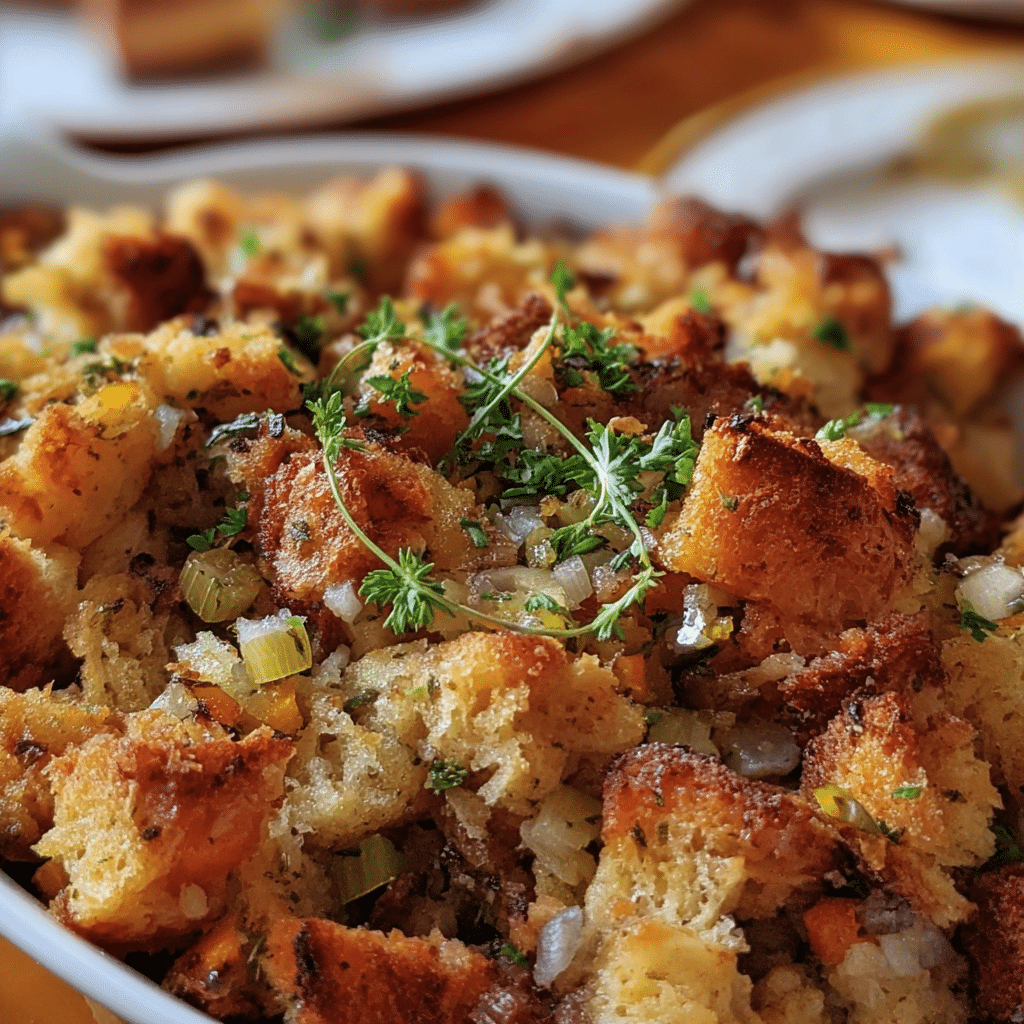
Typically, grandma’s Thanksgiving stuffing can be kept in the refrigerator for about three to four days. If you find yourself with a mountain of stuffing, consider portioning it out into smaller containers. This not only makes it easier to reheat but also helps to cool the stuffing more rapidly, reducing the time it spends in the temperature danger zone.
Freezing and Long-term Storage
If you want to extend the life of grandma’s Thanksgiving stuffing beyond a few days, freezing is a fantastic option. To freeze it, start by allowing the stuffing to cool completely at room temperature. Once cooled, transfer it to a freezer-safe container or a heavy-duty freezer bag. If using a bag, try to remove as much air as possible before sealing it. Label the container or bag with the date so you can keep track of how long it’s been stored.
When stored properly, grandma’s Thanksgiving stuffing can last in the freezer for up to three months. It may still be safe to eat beyond that time, but the quality could decline. If you’re unsure about the texture after thawing, consider using it in a casserole or mixed dish where the stuffing can absorb additional moisture.
To thaw frozen stuffing, transfer it to the refrigerator and let it sit overnight. If you’re short on time, you can use the microwave on the defrost setting. However, be careful not to overheat it, as this could result in a rubbery texture. Once thawed, ensure that you reheat it thoroughly before serving.
Reheating Best Practices
Reheating grandma’s Thanksgiving stuffing requires a bit of finesse to ensure it remains moist and flavorful. The oven is often the best method for reheating stuffing, as it helps to maintain its texture. Preheat your oven to 350°F (175°C). Place the stuffing in an oven-safe dish and cover it with aluminum foil. This will trap moisture and prevent the stuffing from drying out. Heat for about 20-30 minutes, or until it reaches an internal temperature of 165°F (74°C).
If you’re in a hurry, you can also reheat stuffing in the microwave. Place a portion in a microwave-safe bowl and add a splash of broth or water to help retain moisture. Cover the bowl with a microwave-safe lid or wrap it in damp paper towel. Heat in short intervals, stirring in between, until the stuffing is heated through.
Another great method is to reheat it on the stovetop. Heat a skillet over medium heat, add a bit of broth or butter, and stir in the stuffing. This method adds a nice crisp to the edges while keeping the center moist.
As you prepare to enjoy grandma’s Thanksgiving stuffing again, always keep food safety in mind. Reheat only what you plan to eat, as repeated reheating can compromise the dish’s quality and safety. With proper storage and reheating techniques, you can savor that delightful stuffing for days to come.
Finally, remember that meal prep and batch cooking strategies can also help with storage. If you anticipate having leftovers, consider making a double batch and freezing half before the holiday. That way, you’ll always have grandma’s Thanksgiving stuffing on hand for impromptu family gatherings or cozy dinners.
Nutritional Benefits and Health Information
As we gather around the table to enjoy grandma’s Thanksgiving stuffing, we often overlook the nutritional value of this beloved dish. While it’s primarily associated with comfort and nostalgia, this stuffing can also offer a range of nutritional benefits. Understanding the components of this dish can help us appreciate it even more and may even allow us to make healthier decisions as we prepare it.
Nutritional Profile
Grandma’s Thanksgiving stuffing typically consists of bread, vegetables, broth, and various seasonings, each contributing to its unique flavor and nutritional value. A standard serving of stuffing (about 1 cup) usually contains approximately 200-300 calories, depending on the ingredients used.
Breakdown of macronutrients might look something like this:
- Carbohydrates: 30-40 grams
- Protein: 5-10 grams
- Fat: 5-10 grams
Most of the calories in grandma’s Thanksgiving stuffing come from carbohydrates, primarily from the bread used. Whole grain bread can elevate the fiber content, making it a more satisfying option. Fiber is essential for digestive health and can help maintain a feeling of fullness.
Health Benefits
The health benefits of grandma’s Thanksgiving stuffing largely depend on the ingredients you choose. For instance, adding vegetables like celery, onions, or carrots not only enhances flavor but also increases the dish’s vitamin and mineral content. These veggies are low in calories but high in nutrients, providing essential vitamins such as Vitamin C and various B vitamins.
Herbs and spices used for seasoning also bring health benefits. Sage, a common herb in stuffing, is known for its anti-inflammatory properties and potential to improve digestion. Furthermore, incorporating broth made from bones can increase the protein and mineral content, making the stuffing more nourishing.
Dietary Considerations
While grandma’s Thanksgiving stuffing is a delicious tradition, it may not be suitable for everyone due to dietary restrictions. Those with gluten intolerance or celiac disease should avoid traditional bread stuffing. However, gluten-free bread options are widely available and can be used to create a delicious alternative without sacrificing flavor.
Additionally, for vegans or vegetarians, substituting vegetable broth for chicken or turkey broth can easily adapt grandma’s Thanksgiving stuffing to fit dietary needs. There are also ways to reduce the fat content by using less butter or oil in the preparation.
When it comes to calories, grandma’s Thanksgiving stuffing can fit into various diet plans, including balanced diets and even some low-carb diets if prepared with the right ingredients. To make it healthier, consider adding more vegetables or using whole grain bread. You could also reduce the amount of butter or sausage, if included, to lower the calorie count while still enjoying that comforting flavor.
In comparison to other holiday dishes, stuffing is often lower in calories than creamy casseroles or rich desserts. However, moderation is key, especially during the holidays when it’s easy to overindulge. Enjoying a smaller portion of grandma’s Thanksgiving stuffing alongside a variety of other dishes can help balance your plate.
In conclusion, grandma’s Thanksgiving stuffing is not just a delicious side dish; it can also be a nutritious addition to your holiday meal. By being mindful of the ingredients and considering healthier options, you can enjoy this treasured recipe while still supporting your dietary goals. So, as you prepare and share this beloved dish, take a moment to appreciate the flavors, memories, and the nutritional goodness it brings to your Thanksgiving table.
Frequently Asked Questions About Grandma’S Thanksgiving Stuffing
Old fashioned grandma’s thanksgiving stuffing recipe
Grandma’s old-fashioned Thanksgiving stuffing recipe typically features a blend of simple, wholesome ingredients that evoke nostalgia and comfort. Commonly, it includes cubed bread, sautéed onions, celery, and a mix of herbs like sage and thyme. To enhance the flavor, consider adding homemade chicken or turkey broth instead of water, which will enrich the stuffing with a savory depth. For a creamier texture, some recipes incorporate a bit of butter, while others might use a splash of white wine for added complexity. Remember to bake the stuffing until it’s golden brown on top to achieve that perfect crispy texture while keeping the inside moist and flavorful.
Grandma’s thanksgiving stuffing recipe with sausage
Adding sausage to Grandma’s Thanksgiving stuffing recipe introduces a savory richness that elevates the dish. Start by browning your favorite sausage—like Italian or breakfast sausage—in a skillet, and drain the excess fat. Mix the cooked sausage with the sautéed onions, celery, and herbs before folding in the bread cubes. For better flavor integration, let the mixture rest for a bit before baking, allowing the bread to absorb the savory juices from the sausage. Additionally, consider using a mix of bread types for varied texture, and keep an eye on baking time, as the sausage adds moisture that may slightly adjust the cooking duration.
Grandma’s thanksgiving stuffing recipe with bread crumbs
Using bread crumbs in Grandma’s Thanksgiving stuffing recipe gives the dish a fine texture that can be quite delightful. To create your own bread crumbs, simply pulse stale bread in a food processor until fine, or use store-bought options for convenience. Sauté your aromatics—onions, garlic, and celery—in butter, then combine them with the bread crumbs, ensuring that the crumbs are well-coated. To moisten the stuffing, gradually add broth until you reach your desired consistency; the crumbs will soak up the liquid beautifully. Finally, bake the stuffing in a shallow dish for even crisping, adding a sprinkle of herbs on top for a fragrant finish.
Grandma’s thanksgiving stuffing recipe with bread
When using bread in Grandma’s Thanksgiving stuffing recipe, choose a hearty bread like sourdough, challah, or whole wheat to add depth of flavor. Begin by cubing the bread and allowing it to dry out overnight, or toast the cubes lightly to prevent sogginess. Combine the bread with sautéed onions, celery, and herbs, and moisten the mixture with a good quality broth, which helps to bind the stuffing while enhancing its taste. If desired, mix in some chopped nuts or dried fruits for added texture and sweetness. For a beautiful golden crust, bake the stuffing uncovered and consider drizzling a bit of melted butter on top before it goes in the oven to achieve that perfect crispiness.
Conclusion: Mastering the Perfect grandma’s thanksgiving stuffing
Creating the perfect grandma’s thanksgiving stuffing is more than just following a recipe—it’s about understanding the techniques, ingredients, and cultural significance behind this beloved dish. Throughout this comprehensive guide, we’ve explored everything from the historical origins to modern variations, ensuring you have all the knowledge needed to make this recipe your own.
Whether you’re a beginner cook or an experienced chef, the techniques and tips we’ve shared will help you create a grandma’s thanksgiving stuffing that’s not only delicious but also meaningful. Remember that cooking is a journey of discovery, and each time you make this dish, you’ll learn something new.
We encourage you to experiment with the variations we’ve discussed, adapt the recipe to your dietary needs, and most importantly, share it with the people you love. Food has the incredible power to bring people together, and Grandma’s Thanksgiving Stuffing Recipe is the perfect dish to create lasting memories around your dinner table.


